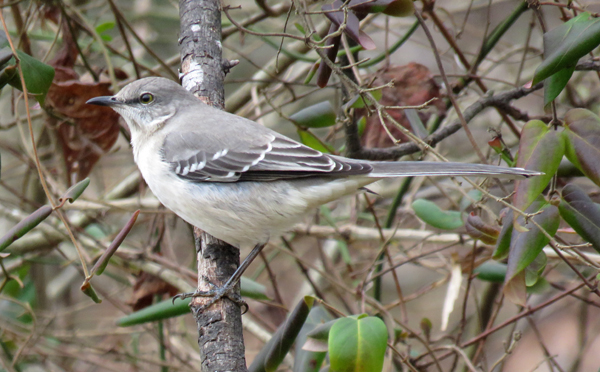
December 31, 2020
Mimus polyglottos
What is known about Mockingbird song?
• 100-200 songs
• Countersings, matching song types
• Nocturnal singing (bachelors) (Kroodsma 2005, Farnsworth et al. 2020)
• Both sexes sing, females less
• Extraordinarily diverse song repertoires
• Persistent mimic
• Songs acquired through imitating: –calls, songs, and parts of songs of other birds –vocalizations of non avian species –mechanical sounds –other mockingbirds
• Two repertoires: spring and fall (Farnsworth et al. 2020)
• Sing in ‘bouts’ (repeat one song type several times)
• Vary how often they return to repeat a bout of a particular song type
(Farnsworth et al. 2020)
• Repertoire size correlates with mating success (Farnsworth et al. 2020)
• Song activity peaks at nest building
• Males sing during February into August (Farnsworth et al. 2020)
• Males sing during the establishment of fall territories (mid-September through November) (Farnsworth et al. 2020)
• Females rarely sing during summer, sing during fall period
(Farnsworth et al. 2020)
• No nocturnal song occurs during the fall (Farnsworth et al. 2020)
He’s a mimic. When I walk along the road by my house in the spring at one spot I regularly hear the phone ring. The mockingbird that resides at that location has learned to mimic a phone. They imitate songs of other birds, mechanical and animal sounds as well as other mockingbirds. When I return there in the fall, he doesn’t mimic a phone.
How and when is song acquired?
• Young begin to sing quietly between one and two months of age
(Farnsworth et al. 2020)
• Learn sounds throughout life (Kroodsma 2005)
• In captivity abnormal song develops when not exposed to song ( Lanyon 1976)
How can we facilitate learning?
• Release as soon as possible: expose for long period of learning to facilitate large repertoire
• Raise with adult mockingbirds
• House outside with singing adults of other species
• Play recordings? xxxxxxxx Find evidence xxxxxxxxxxxxxxxxxxx
– Readily learn all types of sounds
–Play variety of mockingbird song
–Play other species song
Note: mockingbirds repeat song types multiple times in a bout whereas Brown Thrashers tend to sing song types in pairs before switching song type. Kroodsma indicates that gray catbirds, unlike mockingbirds, improvise rather than mimic.
References:
Derrickson, K.C. (1987). Yearly and situational changes in the estimate of repertoire size in Northern Mockingbirds (Mimus polyglottos). Auk. 104(2): 198-207.
Howard R. D. 1974. The influence of sexual selection and interspecific competition on mockingbird song (Mimus polyglottos). Evolution, 28, 428-38.
Kroodsma, Donald.2005. The Singing Life of Birds: 68-79.
Kroodsma, D. E. (1982). Song repertoires: Problems in their definition and use. In Acoustic Communication in Birds, Volume 2: Song Learning and Its Consequences (D. E. Kroodsma and E. H. Miller, Editors), Academic Press, New York, NY, USA. pp. 125–146.
Lanyon, S.M. (1976). Development of song in a Mockingbird hand-reared from the egg in a controlled auditory environment. Kingbird. 26(1): 4-10.
Logan, C. A. 1883. Reproductively dependent song cyclicity in mated male mockingbirds Minimus polyglottos. Auk. 100, 404-13.
Farnsworth, G., G. A. Londono, J. U. Martin, K. C. Derrickson, and R. Breitwisch (2020). Northern Mockingbird (Mimus polyglottos), version 1.0. In Birds of the World (A. F. Poole, Editor). Cornell Lab of Ornithology, Ithaca, NY, USA. https://doi.org/10.2173/bow.normoc.01